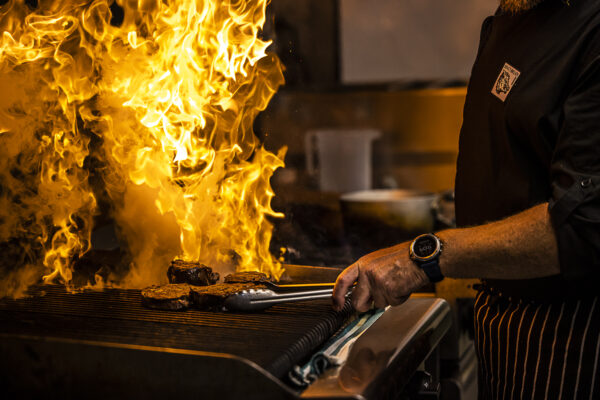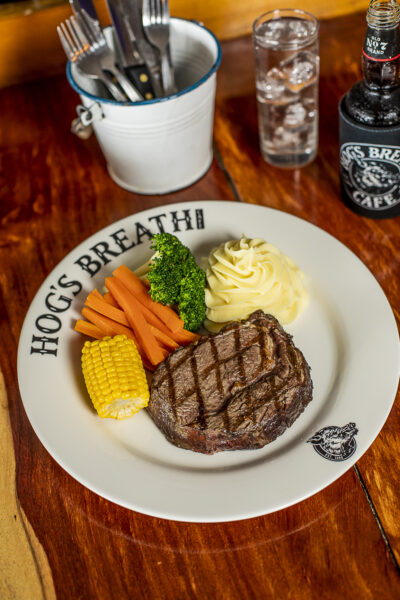Your Ultimate Guide To Cooking Medium Rare Steak

Medium rare steak is known as the best way of cooking steak by chefs and meat lovers. Chefs agree that medium rare steak is the most flavoursome, juicy and tender way to cook steak.
In this guide, you will find out everything you need to know about selecting, preparing and cooking the best medium rare steak. Master the art of the ultimate steak cooking method.
Quick Guide:
What is a medium rare steak?
Selecting the perfect medium rare steak
Thickness of cut
A good amount of marbling
Best cuts of steak for medium rare
Preparing a medium rare steak
How to cook a medium rare steak
Should I cook steak with butter or oil?
Cooking method for medium rare steak
Is your medium rare steak ready?
What is a medium rare steak?
Medium rare steak has a medium red, pinkish center and is juicy and moist. The steak has brown edges and a seared, caramelised exterior. As the cooking temperature is hot enough to break down the fat in the marbling, the juices and flavour are dispersed throughout your steak.
At Hog’s Breath Cafe, our Grill Masters are dedicated to cooking the best Prime Rib Steak in Australia. Our famous 18-hour slow cooked Prime Rib Steak is flame grilled to seal in flavour and is, of course, best served medium rare.
Selecting the perfect medium rare steak:
When choosing your piece of steak, the thickness and cut matters. Head to your local butcher and choose a cut that has these qualities:
- No more than one and a half inches thick.
- A good amount of marbling.
- Choose the most suitable cut.
Thickness of cut:
The reason that steak shouldn’t be thicker than an inch and a half is because the inside of the steak cooks more slowly. With a thick piece of steak, the outside will burn before the inside cooks. A thin cut, on the other hand, will be cooked well done before you have a chance to sear it.
The ideal cut is an inch and a half, which is thick enough to sear each side without burning.
A good amount of marbling:
The secret to beef’s unforgettable taste is the streaks of fat called marbling. Most of the flavour from steak comes from the fat, and without it, steak would be tasteless. Meat with lots of marbling usually has a more intense flavor than lean meat.
Hog’s Breath’s prime rib steak has a vein of marbling that runs through the middle. As it cooks, the fat melts and it makes the meat tender and moist, infusing it with flavour.
The best cuts of steak for medium rare:
The best cuts of steak usually come from the rib or loin sections of the animal.
These cuts include:
Rib: Prime Rib, rib eye
Loin: Porterhouse, T-Bone, Strip, Tenderloin
Jamie Oliver claims that people often overlook the cheaper cuts like flank, oyster blade and skirt skirt when choosing a cut of steak. These cuts have tremendous flavour, buttery texture and marbling.
Preparing a medium rare steak:
An hour before cooking, you need to take your steak out of the fridge and allow it to come to room temperature. When you fry or grill it when it is cold, the heat is not able to cook the middle properly. Before you cook your steak, pat it dry with a paper towel to remove extra moisture.
Seasoning:
A high quality cut of steak is full of flavour on its own, which means that it only needs minimal seasoning. Forget about drowning your steak in a marinade. Season your steak with:
- Olive oil (Rub with olive oil, followed by a sprinkling of salt and pepper).
- Coarse salt.
- Cracked pepper.
Or, herbs such as rosemary, coriander or thyme (if desired)
There is a bit of an art to getting the salt right for pan-frying steak. If you salt steak right before you cook, it can go tough and the salt will draw the moisture out of the meat. This means that it won’t sear properly and you’ll end up with less flavour.
The art is to season it well before you cook the steak, so that the moisture initially absorbed by the salt is given time to infuse back into the steak.
How to cook a steak medium rare:
What type of pan do you need?
You will need a pan that is heavy and holds the heat well. Cast iron cookware is perfect as it holds heat well and gives you a caramelised, seared meat. The beauty of a cast iron skillet is that you can pre-heat it without needing to add oil or butter, which is better for you.
Teflon and non-stick pans, even stainless steel ones can’t be preheated without damaging the pan.
Tip: Avoid Teflon as high heat will ruin your skillet.
Preheat your pan:
Heat a cast iron skillet over high heat for approximately 10 minutes. The pan will smoke a bit when it is ready.
While you are waiting for the pan to pre-heat, brush your steak with olive oil. Adding oil to your steak, instead of the pan, means that you use less oil and won’t end up with a smokey kitchen.
Make sure your pan is extra hot before you begin as it will help caramelise the meat, creating a delicious, seared crust.
Tip: Don’t overcrowd the skillet.
Should I cook steak with butter or oil?
Butter has a low smoke point and turns black, even at low temperatures. Oliver oil is ideal for searing steak. To give your steak a buttery flavour, add slices of butter into your pan before shortly before you are finished cooking.
Cooking method for medium rare steak
- Sear steak for 4-5 minutes on each side.
- Turn your meat once in the pan.
- Steak should feel soft and spongy, with a slight bit of resistance.
- Internal temperature: Approximately 60-65 degrees Celsius.
- Rest meat, after cooking, for 5 minutes. As the steak is resting it will continue cooking and the internal temperature will rise slightly, so we suggest taking off the pan when the core of your steak reaches 60 degrees Celsius (a good probe-style thermometer is a must!)
Don’t move the steak until it has formed a brown crust. The secret of the unbeatable flavour of cooked steak is the Maillard reaction. When you sear the meat, forming a brown crust, a chemical reaction between the amino acids and sugars gives the browned steak a distinctive flavour. The Maillard reaction explains the incredible taste of steak, roasted coffee and freshly baked bread.
When you pan fry steak, always use tongs to flip the steak or move it around. Don’t use a fork, or you’ll pierce the steak and lose all the juices. The juices give your steak flavour and tenderness, which is the reason why well done steak (which is cooked until the moisture evaporates) is flavourless and bland.
Is your medium rare steak ready?
There are three methods of testing if your steak is ready:
- By touch.
- Meat thermometer.
- Cutting your meat.
By touch:
Although this method takes a bit of practice, it is a culinary skill worth learning. Instead of cutting or piercing the steak, with a knife or thermometer, you will leave the steak intact. This means that the juices and moisture won’t escape from your steak.
Press the surface of your steak lightly. If it feels soft, then it is rare. If it feels firm on the outside, with a bit of spongy resistance on the inside, then it is medium rare.
Meat thermometer:
A meat thermometer is a fool-proof way of checking if your steak is ready. Although it makes a hole in the steak, which means that the juices will escape, it gives you an accurate way of checking your steak.
Internal temperature:
Rare: 55-60 degrees Celsius.
Medium rare: 60-65 degrees Celsius.
Medium: 65-70 degrees Celsius.
Well done: 80 degrees Celsius.
Rest:
It’s tempting to cut straight into your steak when you first remove it from the pan. If you slice it immediately, the juices will escape onto your cutting board. It’s the juices that give your steak tenderness and intense flavour.
As your meat heats up in the pan, the protein goes hard and the muscle fibres compress. The heat pushes the moisture towards the centre of your meat. Resting the steak allows the fibres to relax and moisture to disperse throughout your meat.
The rule of thumb is to let your steak rest for approximately five minutes, per inch of thickness, before serving. Wrap it loosely with aluminium foil and put it on a warm plate.
With this guide, you’ll be able to master the art of cooking medium rare steak. All you need is a bit of practice, the right cut of steak and our know-how.
Hungry right now for a great medium rare steak and don’t want to cook it? Find your Local Hog’s Breath Cafe here.

